S&P Global Offerings
Featured Topics
Featured Products
Events
S&P Global Offerings
Featured Topics
Featured Products
Events
S&P Global Offerings
Featured Topics
Featured Products
Events
Banking & Capital Markets
Economy & Finance
Energy Transition & Sustainability
Technology & Innovation
Podcasts & Newsletters
Banking & Capital Markets
Economy & Finance
Energy Transition & Sustainability
Technology & Innovation
Podcasts & Newsletters
S&P Global Offerings
Featured Topics
Featured Products
Events
Research — JUNE 19, 2025

By Keith Nissen
Survey findings show that three out of 10 Americans watch Major League Baseball (MLB) and three-quarters of MLB fans engage in sports-related activities beyond watching games. MLB viewers who are highly engaged sports fans tend to be predominantly young, college-educated men.

➤ Over the past two years, MLB viewership has remained steady at about 30% of US internet adults.
➤ Among MLB viewers, 76% were engaged sports fans and 24% only watched live sports without participating in other sports-related activities. Other than watching live professional sports, the most popular sports-related activities included watching highlights and buying team merchandise.
➤ Forty-four percent of MLB viewers indicated low engagement with sports, 32% were moderately engaged, and 23% were highly engaged sports fans.
➤ MLB viewers who indicated low engagement tended to be older (age 55+) adults with a fairly even gender and education split. Highly engaged MLB viewers were most likely to be younger (under 44 years of age), male, college-educated adults.

The S&P Global Market Intelligence Kagan US first-quarter 2025 Consumer Insights survey found that 29% of respondents typically watch, or plan to watch Major League Baseball (MLB) games. Historical survey data shows that MLB viewership has remained essentially flat, hovering around one-third of US internet adults over the past two years.
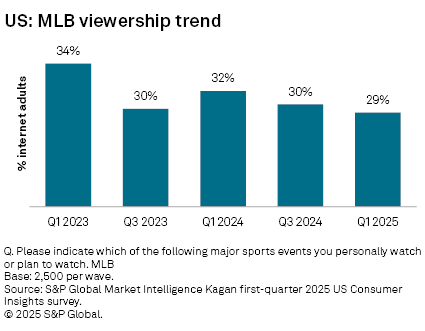
The first-quarter 2025 survey asked respondents about their level of overall sports engagement. The following chart compares this data to first-quarter 2024 survey results that measured MLB-specific fan engagement. For example, the 2025 survey found that 85% of MLB fans watch live TV sports using either a traditional pay TV service or through an online streaming service, such as MLB.TV. This is only slightly above the 77% of MLB fans in 2024 who said they specifically watch MLB games on TV. The survey data also shows that 41% of MLB fans attend some type of sporting event in person but only 27% attend live MLB games. This emphasizes the importance of TV to overall MLB viewership.
In addition, the survey highlights the gap between overall sports engagement among MLB viewers and MLB engagement specifically. For instance, half (50%) of MLB fans said that they watch sports highlights, interviews and online video clips in general, compared to 39% of MLB fans that watch MLB highlights and other MLB short-form content. Similarly, one-third (33%) of MLB fans buy sports merchandise, but only 18% of MLB fans buy MLB-related merchandise. This suggests that the MLB has an opportunity to substantially increase fan engagement by targeting MLB fans that are already engaged in some way with another sport.
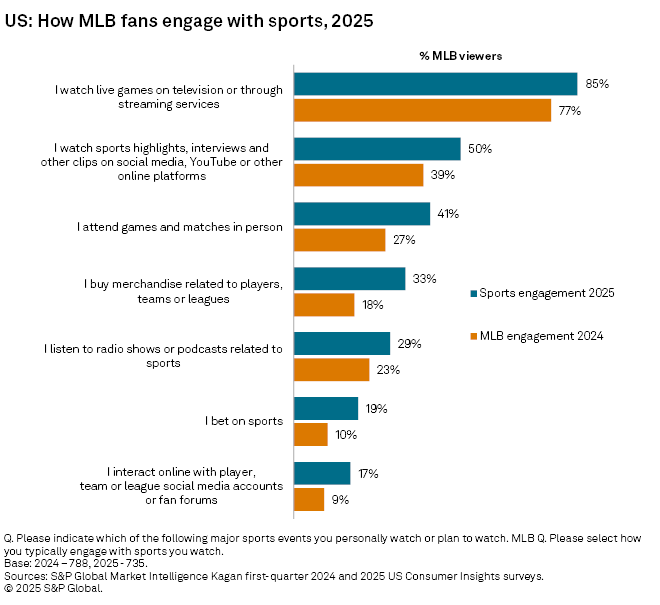
Sports engagement, in general, can be used to identify MLB fans who are most likely to engage with the MLB. To illustrate, three sports engagement segments were created based on eight sports-related activities performed, ranging from TV sports and highlights viewing to merchandise purchases, sports betting and participation in online fan forums. MLB fans surveyed in 2025 who said they perform one or two of these activities were grouped as those with low sports engagement. MLB fans who perform three or four activities were segmented into the moderate sports engagement category and those who indicated that they participate in five or more activities were considered to have high sports engagement.
The table below shows that the vast majority of MLB fans watch live sports on TV. However, those with low engagement, representing 44% of total MLB fans, tend not to participate in most other activities. Those that are moderately engaged (32% of MLB fans) are much more likely to watch sports highlights, attend games in person, buy merchandise and listen to sports radio/podcasts than modestly engaged fans. The majority of those that are highly engaged (23% of MLB fans) participate in all of the sports engagement activities.
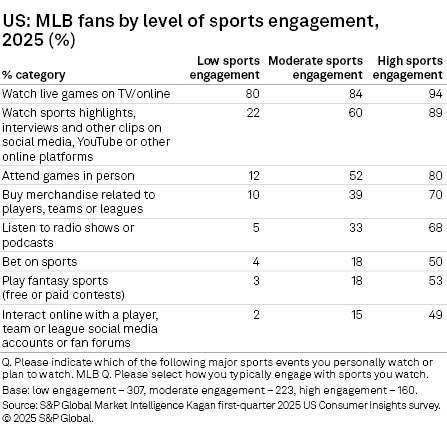
Examining the sports engagement segments by age shows that nearly two-thirds of modestly engaged MLB fans are adults 55 years of age and older. Close to half (47%) of moderately engaged MLB fans are also older 55+ adults. However, highly engaged MLB fans tend to be far younger, with 58% being age 44 or below and 30% being in the 18-34 age group.
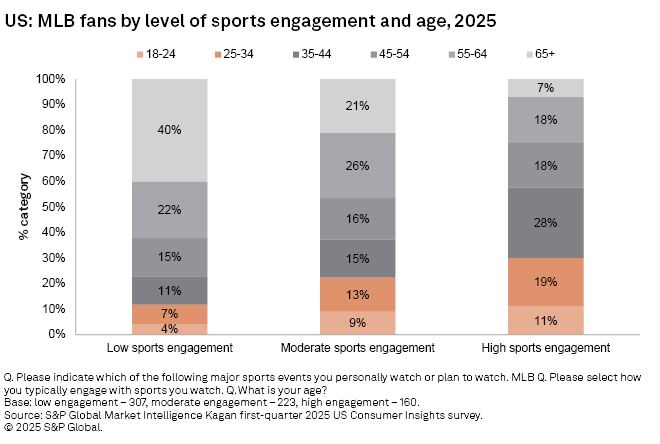
With regard to gender, there is a fairly even split among modestly engaged MLB fans. Two-thirds (63%) of those moderately engaged and nearly three-quarters (71%) of highly engaged MLB fans were men. The survey data shows that household income was not an overly significant factor in determining sports engagement, as compared to education. Approximately six in 10 modestly engaged MLB fans were college graduates, rising to 78% for highly engaged sports fans.
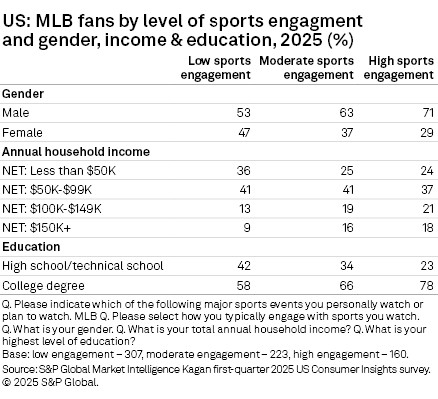
The survey also found very little difference in average daily TV/video viewing hours among the three sports engagement segments, closely matching that of the overall US internet adult population (5.5 hours per day). With regard to the content being watched, each of the sports engagement segments spent just under one-quarter of their daily TV/video viewing hours watching news programs. As might be expected, time spent watching sports increased along with the level of sports engagement, but the largest portion of daily viewing hours for each segment was dedicated to entertainment other than news and sports.
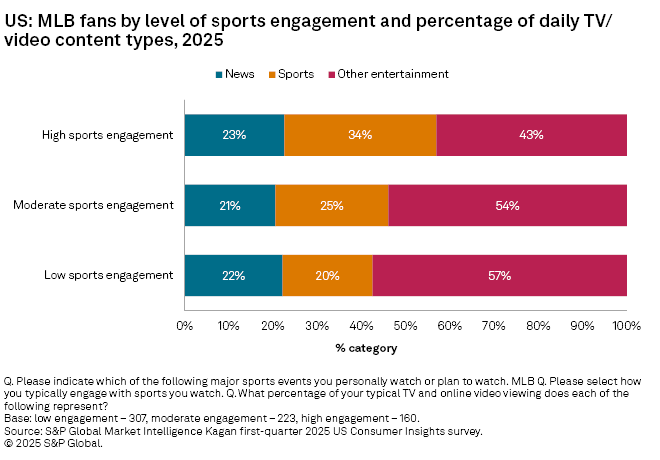
This article was published by S&P Global Market Intelligence and not by S&P Global Ratings, which is a separately managed division of S&P Global.
Consumer Insights is a regular feature from S&P Global Market Intelligence Kagan.
The Kagan first-quarter 2025 US Consumer Insights survey was conducted in March 2025. The survey consisted of 2,501 internet adults with a margin of error of +/-1.9 ppts at the 95% confidence level. Survey data should only be used to identify general market characteristics and directional trends.
